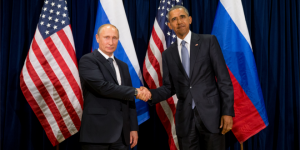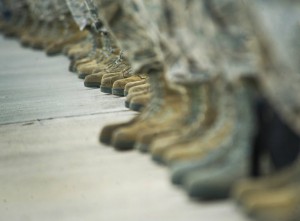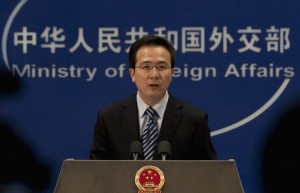UK: Majority support for cooperating with Russia and Assad on Syria
59% of British people support Britain and the US cooperating with Russia in the fight against ISIS in Syria – and support for sending ground troops back into Iraq is increasing
Russia began bombing opponents of president Assad in Syria yesterday, giving the US only an hour’s warning. Russian defence officials said the attacks on rebel-controlled areas were targeted at ISIS militants, however US officials said there was no evidence ISIS held the territory – there are now concerns Russia is targeting all forces opposed to president Assad, possibly even US-backed Syrian forces. The news came two days after Vladimir Putin met with Barack Obama about the need to work with Assad in Syria, an alliance the US has ruled out repeatedly.
David Cameron said this week he would “work with anybody” to defeat Assad and ISIS, including Russia and Iran. New YouGov research reveals the majority of British people (59%) would approve of British and US forces cooperating with Russia to fight ISIS.
Opinion also balances slightly in favour of cooperating with Assad to fight ISIS (38% would approve, 32% would disapprove). Many people are unsure (30%).
Russia is opposed to ground troop operations and Britain’s history in Iraq has made the suggestion unpopular in the past, but as Iraq destabilises and loses ground to ISIS British opposition to ground troops is fading away.
Now more people support Britain and the USA sending ground troops back into Iraq to help fight ISIS (40%) than oppose (39%). In July, when YouGov last asked, people were divided 39%-39%, but before then opposition was clear.
British support for RAF air strikes in Syria, which is to be debated in the Commons soon but may struggle to pass without the support of Jeremy Corbyn’s Labour, remains strong. 60% support and 20% oppose.
The prime minister regrets being defeated in parliament in 2013 over air strikes in Syria brought on by Assad’s use of chemical weapons and barrel bombs in 2013. Many now believe that intervention then, before rebel forces became fractured and infiltrated by ISIS and al-Qaeda militants, could have abated the current conflict, even easing the current refugee crisis largely brought on by people fleeing Assad’s regime.
September 2015: thanks to everybody for the 226,777 contacts and hundreds e-mail. Stay tuned!
The West must face reality: only a ground war can stop Islamic State
It’s a thorny issue that has experts divided. For some, a ground war is a trap and should not even be considered; only well-targeted, reinforced airstrikes will do the job. For others, it’s impossible to slay ISIS without hunting down its jihadists one by one, from street to street, hideout after hideout, a strategy that requires the immediate deployment of sufficient numbers of ground troops.
Others still, believe that we’re targeting the wrong enemy. The fight against terrorism, they say, is not like a traditional military confrontation, but first and foremost the work of intelligence services and the police.
Between a war in the air, on the ground, or a secret war, citizens — who know less than the so-called experts — often have little more than their prejudice as a compass. And yet, despite their lack of understanding, a moment of common sense can help them see more clearly.
Everybody knows by now that ISIS beheads, tortures, rapes, slaughters, manipulates, dehumanizes. This so-called “Islamic State” destroys the bodies, the souls, the relics of the past, the art — in other words, everything that makes up humanity.
Nobody doubts that the cruelty of this group is without boundaries, that its determination is unyielding and its savagery extreme. And everybody can easily see that ISIS is getting bigger and stronger by the day. Tthe more atrocities it commits, the more its power of attraction on the world’s angry masses intensifies and the more branches and allied groups are created, from the Maghreb to central Africa, and beyond.
Unless we’ve become desperately naive, it’s impossible to still imagine we could confine this danger and limit its scope. There is no such thing as a safebox where we can leave ISIS to rot. If we don’t fight it, corpses will keep piling up, entire populations will be destroyed and more ancient temples will be blown to dust. Not fighting it will lead to terrorism spreading all over the globe, creating uncontrollable situations everywhere.
Common sense commands us to move to the rapid and total destruction of ISIS.
The terrorist group has time on its side. Hesitations and inefficient operations allow it to prosper and even to progress, step by step, in establishing a caliphate that dreams of becoming perennial and reaching worldwide. The later the great confrontation will come, the more difficult and uncertain the outcome will be.
Pacifism’s grip
As things stand today, defeating ISIS’ 30,000 men — even if they’re well equipped, determined and radicalized — is definitely within the reach of our armies. But if tomorrow they’ve grown more numerous and better equipped, scattered across more territory, operations will be even more risky and their outcome more difficult to predict.
At that point , the situation becomes entirely unthinkable.
That said, an efficient war is hardly easy to organize, and strategic, political and diplomatic hurdles must first be overcome. We’d need to secure a European consensus, cooperation from Arab countries, a transformation of America’s stance … In other words, nothing that’s simply or quickly obtained, to say the least.
But the biggest stumbling block is within each of our heads. It’s been a long time since we’ve ceased to understand the Clausewitz formula, according to which “war is merely the continuation of politics by other means.” After two world wars, the construction of a peaceful European coexistence and the United Nations’ system, pacifism itself has become second nature for most Westerners. The idea of a “just war,” which used to be all too common, now seems strange, unreal or even obscene.
We look at 20th-century fighting with a mixture of dread and incredulity. After some time, we surely understand that to eradicate savagery, it was necessary to take up arms. But we’ve failed to grasp the direct connection with the present. Until now, at least.
Those who see that connection say we can’t afford to wait until it’s too late. They cannot, therefore, keep quiet about it, even though they risk looking like blind warmongers and being labeled as “Neocons” and many other nasty things. But given the nature of ISIS, of how it acts and what it can become, it seems now as if a war on the ground is the only solution that remains. Of course, it’s also the worst solution.
Except, maybe, for all the others.
Fighting Islamic State online
The two men pecked out messages on opposite sides of the country. “Yes the Islamic State was a fantasy in 2004, now look at it. The U.S. was a fantasy in 1776, now look at it,” the man in Virginia wrote in a Twitter direct message to an online friend in Oregon. The Virginian, who went by various Twitter handles, including one with “Jihadi” in it, had been obsessively watching slick online videos produced by the Islamic State, also known as ISIS: brutality and jihadist propaganda, much of it translated into English and other languages. Now he was talking about traveling to Syria and forming a militia in Virginia. “Washington beat an empire with 3 percent of the population. I can do it with 1 percent.”
His correspondent in Oregon was Paul Dietrich, a programmer and digital activist joining jihad-related Twitter conversations out of curiosity. Alarmed, he did what relatively few are doing: he tried to intervene with someone who was showing signs of being radicalized by ISIS’s social-media campaign. Dietrich heard the man’s grievances sympathetically, tried to talk common sense, and suggested he get psychological help. Then one night he called the Virginia man “stupid.”
“How am I stupid?” he responded.
“Let me count the ways. You are a jihadist, in America, who wants to start a militia, and you think you’ll win,” Dietrich wrote. “Stop. This. Madness. While. You. Can.”
The Virginia man was, at least, talking. “I’ll think about it.”
Extremist groups have long used the Internet, and citizens have long left home to fight for their countries’ enemies. But ISIS stands apart in the way it’s mastered online propaganda and recruitment. Using 21st-century technology to promote a medieval ideology involving mass killings, torture, rape, enslavement, and destruction of antiquities, ISIS has been the prime mover among Islamist groups that have lured 25,000 foreigners to fight in Syria and Iraq, including 4,500 from Europe and North America, according to a U.S. government report released this week. “The ISIS social-media campaign is a fundamental game changer in terms of mobilizing people to an extremist cause,” says Amarnath Amarasingam, a researcher at the University of Waterloo who is co-directing a study of Western fighters in Syria. “You are seeing foreign fighters from 80 or 90 countries. In terms of numbers and diversity, it has been quite stunning.” As Google’s policy director, Victoria Grand, told a conference in Europe in June: “ISIS is having a viral moment on social media, and the countervailing viewpoints are nowhere near strong enough to oppose them.”
Indeed, the technological response to stanching the recruitment isn’t having much of an effect. Internet companies close accounts and delete gory videos; they share information with law enforcement. Government agencies tweet out countermessages and fund general outreach efforts in Muslim communities. Various NGOs train religious and community leaders in how to rebut ISIS messaging, and they create websites with peaceful interpretations of the Quran. But what’s missing is a widespread effort to establish one-on-one contact online with the people who are absorbing content from ISIS and other extremist groups and becoming radicalized.
Humera Khan, executive director of Muflehun (Arabic for “those who will be successful”), a Washington, D.C., think tank devoted to fighting Islamic extremism, says people like her and Dietrich who try such online interventions face daunting math. “The ones who are doing these engagements number only in the tens. That is not sufficient. Just looking at ISIS-supporting social-media accounts—those numbers are several orders of magnitude larger,” says Khan. “In terms of recruiting, ISIS is one of the loudest voices. Their message is sexy, and there is very little effective response out there.Most of the government response isn’t interactive. It’s a one-way broadcast, not a dialogue.”
Reversing the tide will require, among other things, much more of what Khan and Dietrich have done. What’s needed is better ways to identify the people most at risk of being persuaded by extremist messages and more reliable ways to communicate with them. As an example, a London think tank called the Institute for Strategic Dialogue recently piloted experiments in which it found people at risk of radicalization on Facebook and tried to steer 160 of them away. It was a small test, but it shows what a comprehensive peer-to-peer strategy against extremism could look like.
Distribution mechanisms
ISIS differs from previous radical Islamic movements. For one thing, it forged important alliances to capture territory. After merging al-Qaeda factions with elements of Saddam Hussein’s military and intelligence agencies, it seized two major cities, Raqqa in Syria and Mosul in Iraq—a region with more than six million inhabitants (at least before the latest mass migrations), substantial resources of oil, water, and wheat, and institutions such as universities. Al-Qaeda, in contrast, never controlled more than a few pockets of territory in such places as Somalia and Yemen. “Never before had a jihadist movement gained the kind of territory and wealth that might allow them to function like states and run public relations campaigns,” says Nico Prucha, a researcher at the University of Vienna and a fellow at the International Center for the Study of Radicalization at King’s College London.
Second, ISIS differs ideologically from other jihadist groups. A few days after ISIS grabbed Mosul in 2014, a stern-faced, black-robed man ascended stone steps in a mosque and claimed the grandest title of them all: “Caliph,” leader of all Muslims, successor to the Prophet Muhammad, with aims to unite Muslim lands into a caliphate much like the ones that rose and fell in the first millennium. The man was Abu Bakr al-Baghdadi, ISIS’s leader. He had cleverly attached his extremist cause to a larger idea that resonates with many Muslims: the restoration of the caliphate.
“Really, you are dealing with a social movement in the true sense—it’s no longer just ‘a group’ that people are joining,” says Mubin Shaikh, a former extremist in Toronto. He has worked undercover for Canadian intelligence services on several investigations, one of which involved infiltrating the “Toronto 18,” a group of young Muslims charged with planning terror attacks in 2006. Today, he also advises U.S. counterterrorism agencies and tries to intervene online to stop young people in Toronto’s Muslim community—the largest in North America—from becoming radicalized.
“People will make analogies to fighters joining the Spanish Civil War,” Shaikh says. “While I understand the analogy, I don’t think it applies. This is really peculiar to the Muslim context. The Muslim world—especially the young Muslim world—has been psychologically primed for a long time to the idea of reëstablishing the caliphate. It’s this idea that Muslims are living under humiliation, and the only time we were not is when there was a caliph. It really is an idea of reclaiming lost glory.”
Third, ISIS emerged after important technological shifts. Think back to when terrorists made their first beheading video, in 2004. According to the CIA, this grainy and gruesome piece of media likely shows Abu Musab al-Zarqawi (the leader of al-Qaeda’s branch in Iraq, which later morphed into ISIS’s predecessor) slaughtering Nick Berg, a radio entrepreneur from Pennsylvania. It was a laborious task to upload this file onto a jihadist Web forum. There was no YouTube or Twitter to allow instant sharing of videos or links to them. Facebook was still a dorm-room plaything. Few people had smartphones. Al-Qaeda used news organizations such as Al Jazeera to release its videos and statements. Today, however, affordable devices, fast networks, and abundant social-media accounts directly feed a spectacularly large potential audience of young people. A recent study found that the world’s 1.6 billion Muslims have a median age of 23.
The notional head of ISIS’s media operations is a 36-year-old Syrian named Abu Amr al-Shami, who had been the ISIS boss in Aleppo, according to the Soufan Group, a consultancy whose leaders include former U.S. and U.K. counterterrorism officials. The propaganda effort includes a slick online magazine called Dabiq. And there’s a division called Al Hayat Media, which targets Western audiences. It’s run by a German rapper formerly known as Deso Dogg who now calls himself Abu Talha al-Almani, according to the Middle East Media Research Institute. His oeuvre includes recruitment videos, called Mujatweets, in which you might see fighters handing out ice cream to children.
But the larger social-media campaign is aided by sympathizers in the Middle East, North Africa, and elsewhere who produce their own content in multiple languages. This decentralized approach makes it hard to go after the people producing it. “They can do this anonymously from wherever they live,” says J. M. Berger, a nonresident fellow in the Project on U.S. Relations with the Islamic World at the Brookings Institution and coauthor of a paper called “The ISIS Twitter Census.”
The propaganda consists of more than graphic videos; it adroitly addresses national, local, and tribal grievances. For example, on February 3, videos surfaced of ISIS soldiers forcing a captured Jordanian fighter pilot, Moaz al-Kasasbeh, into a metal cage—and then burning him to death. Western media reports focused on the deed’s barbarity, but the fire starts 18 minutes into the video. The bulk of it lays out a detailed argument for the act, making connections between President Obama and Jordanian leaders; between American-made armaments and Jordanian air strikes on ISIS; and between those air strikes and the dead and bloodied on the ground in Raqqa. Under the logic of “an eye for an eye,” ISIS had a justification for the fighter pilot’s execution, and the act had a clear political goal as well, Prucha explains. It was designed to drive a wedge between King Abdullah of Jordan, who is close to al-Kasasbeh’s uncle, and the many refugees from such airstrikes who are living in the country. For good measure, the text was translated into French, English, and Russian.
The propaganda put out by Dabiq, the ISIS magazine, includes articles geared to certain audience segments. Recruitment pitches for women, for instance, emphasize themes of sisterhood and belonging—and highlight the role of marriage and family in bolstering “Brand Caliphate,” as Sasha Havlicek, founder of the Institute for Strategic Dialogue, puts it. As potential recruits are wooed, ISIS supporters engage them in one-on-one chats that are often steered to all-encrypted channels.
In trying to understand why ISIS is so adept at all this, one comes back to a simple explanation. The people doing it grew up using the tools. “When you say ‘terrorist use of social media,’ it sounds ominous, but when you look at it as ‘youth use of social media,’ it becomes easier to understand,” says Khan. “Of course they are using social media! They are doing the same thing youth are doing everywhere.”
Scaling up
As he pulls up to meet me at the Toronto City Airport in his cluttered Dodge Caravan, Shaikh, with his gray-flecked pencil sideburns, looks like the 40-year-old, minivan-driving father of five that he is. Two decades ago, however, he was a disaffected, hard-partying Toronto punk who latched onto Islamic extremism. So he understands ISIS’s target audience today. And like Dietrich and Khan, he sometimes tries to tackle the exhausting task of engaging online.
At one point, to attract possible extremist followers, he created a Twitter username, “@CaliphateCop” (he later deleted it, but now the name is used by another Twitter user), and included a quote from the Quran in his profile. He would jump into Twitter conversations and soon engaged with many people professing support for extremist causes. One was, Shaikh says, an al-Qaeda supporter in Syria. “How can you sleep at night knowing Muslims are in prison due to your snitching?” the Syrian wrote. Shaikh shot back: “How can U claim any sort of Islam and accept the random killing of civilians? Where the heck did U learn your religion?”
“Allah Al Musta-an!!” (roughly equivalent to “Oh my God!”) came the reply. “Canada participated in the destruction of the Islamic emirate, they have no innocents for their crime.”
Shaikh countered: “Really? Random people walking2work who hav zero attachment2 what govt does—they’re legit targets?”
The Syrian had his rationalization ready: “Who was the first person in Islam to use the catapult? It was the prophet. And we both know the catapult doesn’t only hit enemy combatants.”
Social-media research has shown that messages from friends and peers are more persuasive than general advertising. Other bodies of research show that youth at risk of falling into many kinds of trouble, from drugs to gangs, often benefit from even small interventions by parents, mentors, or peers.
But so far, major anti-ISIS programs don’t involve that kinds of outreach. For example, over the summer the British government launched a tweet campaign to broadcast government messages against ISIS. Some $188 million from U.S. government agencies funds anti-extremist projects and other community-engagement programs around the world, including one aimed at stanching recruitment inside prisons. And there are efforts to develop new social technologies. Affinis Labs, based in Arlington, Virginia, describes itself as a Y Combinator–like incubator for Muslim-centric apps. One is “QuickFiqh,” in which youths ask 60-second questions about Islamic law and get 60-second answers from mainstream Islamic scholars, made to be easily shared on social media. But these efforts are aimed at Muslims more generally and don’t specifically target people showing signs of becoming radicalized.
Shaikh and others doing peer-to-peer work say they’re frustrated because they can’t know whether the people they talk to online are the ones most at risk or are too far gone and thus a waste of effort. They also want more evidence about what approaches and messages are most effective. So this year the Institute for Strategic Dialogue decided to develop a systematic peer-to-peer anti-extremism strategy. First the group recruited 10 former extremists (five from far-right groups, five from jihadist groups) to serve as “interveners.” Next, they used a Facebook feature called Graph Search to find people whose interests, pages liked, group memberships, and other indicators showed they were likely to be moving toward extremism. The interveners winnowed the list to 160 people and used a little-known “pay per message” feature (you can pay $1 to send a message to a stranger) to start a dialogue. The preliminary results showed that most recipients responded, a crucial first step. Some 60 percent started a “sustained engagement” when the initial overture was nonjudgmental and empathetic.
The study pointed, in a crude way, to what might be possible at a larger scale. “Social media has assisted extremist causes, but there are many ways for us to push back using the same tools,” says Ross Frenett, who led the study. “We just haven’t optimized that. We haven’t pursued that.”
Today, ISIS still dominates in the online struggle. Young people continue to leave Western countries for the battle zone. But every now and then, there are small victories. Khan and Dietrich say the young man in Virginia is seeking mental health treatment. Though known to the FBI, he has not been charged with any crime. Having started down the path of radicalization, he may be on his way back because of a few people talking to him online, one on one.
technologyreview.com
Donald Trump: “Let Russia fight Islamic State”
Presidential candidate Donald Trump late Monday offered his approach for fighting with the Islamic State in Iraq and Syria (ISIS).
“Why are we knocking ISIS, and yet at the same time we’re against [Syrian President Bashar] Assad? Let them fight, take over the remnants,” Trump said on CNN’s “Out Front,” calling Syria a “total catastrophe.”
“But more importantly, let Russia fight ISIS, if they want to fight them, in Syria,” Trump said. “We can fight them in Iraq,” Trump added.
“Let ISIS and Syria fight. And let Russia, they’re in Syria already, let them fight ISIS,” Trump said. “Let Russia take care of ISIS.”
President Obama and Russian President Vladimir Putin met privately for 90 minutes Monday to discuss Syria after giving dueling addresses at the United Nations General Assembly in New York.
“Yesterday’s meeting was genuinely constructive,” Secretary of State John Kerry said Tuesday on MSNBC’s “Morning Joe.”
The pair discussed issues such as having a unified Syria, that ISIS must be taken on and that there needs to be an organized transition in Syria, Kerry said.
ISIS is considered a threat to Assad, whom the U.S. wants out of power but Putin believes is key to defeating ISIS.
250 americans among thousands who entered Iraq, Syria to join Islamic State
Nearly 30,000 foreign fighters from more than 100 countries have traveled to Iraq and Syria since 2011, mostly to join the Islamic State (ISIS/ISIL), the New York Times (NYT) reported, citing anonymous intelligence and law enforcement officials.
The new figure marks “a doubling of volunteers in just the past 12 months and stark evidence that an international effort to tighten borders, share intelligence and enforce antiterrorism laws is not diminishing the ranks of new militant fighters,” noted the Times.
NYT learned from intelligence and law enforcement officials that “among those who have entered or tried to enter the conflict in Iraq or Syria are more than 250 Americans, up from about 100 a year ago.”
President Obama, during his address to the United Nations General Assembly, vowed to “compromise” with Iran and Russia on combating ISIS in Syria.
American intelligence analysts are “preparing a confidential assessment that concludes that nearly 30,000 foreign fighters have traveled to Iraq and Syria from more than 100 countries since 2011,” reported the Times. “A year ago, the same officials estimated that flow to be about 15,000 combatants from 80 countries, mostly to join the Islamic State.”
News reports have surfaced accusing the Pentagon of altering ISIS intelligence reports to fit the president’s political narrative that he is winning the war against the jihadist group. A group of Republican lawmakers are demanding answers on why the intelligence assessments were changed.
President Obama is expected to chair an international summit on the sidelines of the UN General Assembly for international leaders combating ISIS and “violent extremism” as a whole.
Iran’s designation by the United States as the most active state-sponsor of terror precludes it from participating in the summit, reports The Guardian.
Nevertheless, Obama told the UN General Assembly that he is willing to work with Iran and Syria to resolve the Syrian conflict.
“Lasting stability can only take hold when the people of Syria forge an agreement to live together peacefully,” said the president. “The United States is prepared to work with any nation, including Russia and Iran, to resolve the conflict.”
“Realism dictates that compromise will be required to end the fighting and ultimately stamp out ISIL,” conceded Obama. “But realism also requires a managed transition away from [Syrian dictator Bashar] Assad into a new leader and an inclusive government that recognizes that there must be an end to this chaos so that the Syrian people can begin to rebuild.”
Agence-France Presse (AFP) reports that an assessment of the foreign fighter flows by the U.S. Congress is expected to paint an even “bleaker picture, suggesting that a year of US-led air strikes has not slowed recruitment.”
The Pentagon has set up a $500-million program to train “moderate” Syrian rebels that has proven to be an embarrassment.
U.S. Central Command (CENTCOM), the military headquarters overseeing the American bombing campaign and other efforts against ISIS, admitted that the second group of trained fighters deployed into Syria surrendered some of the U.S.-supplied weapons and vehicles to al-Qaeda’s affiliate in Syria, the al-Nusra Front, in exchange for “safe passage.”
The first group of nearly 60 U.S.-trained fighters was defeated by the al-Nusra Front.
A global coalition against islamic terrorism
Addressing the United Nations General Assembly for the first time in more than a decade, Russian President Vladamir Putin called Monday for a broad anti-terror coalition aimed at stopping the Islamic State—and in a pointed challenge to President Barack Obama, hinted that this coalition should back the regime of Syrian President Bashar al-Assad.
The team, Putin explained, would be “similar to the anti-Hitler coalition.” Speaking about the Islamic State in lurid terms, he added, “We cannot allow these criminals who have already tasted blood to return back home and continue their evil.”
“Russia stands ready to work with its partners on the basis of consensus,” Putin said. It’s not clear, though, whether he expects the US to be one of these “partners.” According to the Washington Post, Putin has historically used the word “partners” to refer to countries with whom relations are tense.
Putin also spoke gravely about the lack of political stability in the Middle East and North Africa after the Arab Spring, saying, “Nobody cares a bit about human rights, including the right to life. I cannot help asking those who have caused the situation, ‘Do you realize now what you have done?'”
Putin’s remarks come on the heels of Sunday’s news that Russia, Iraq, Iran, and Syria had entered an agreement to share military intelligence about the Islamic State. The announcement blindsided United States intelligence officials, according to the New York Times.
In his own Monday address to the General Assembly a few hours earlier, President Obama claimed that he’d be willing to work with “any nation, including Russia and Iran,” to create a resolution that would help put a stop to the crisis in Syria. But the methods he endorsed contrast sharply with Putin’s. He also ruled out working with “tyrants like Bashar al-Assad,” and said there could be no “return to the previous status quo” in Syria.
China ready to join international fight against terrorism — foreign ministry
China is ready to join the international fight against any forms of terrorism, China’s Foreign Ministry spokesperson Hong Lei told a regular news conference while commenting on information in some media about Chinese warships near Syria being ready to take part in a mission against the Islamic State (IS) terrorist organization.
“Terrorism is the enemy of mankind,” he said. “China is against terrorism in all of its forms and is ready to apply efforts for fighting terrorist forces jointly with the international community. This position of China remains unchanged.”
However, the spokesman could not confirm information about Chinese warships near the Syrian coast being ready to patrol the region.
“As for the situation you are asking about,” he told the reporter who asked the question, “I do not have that information.”
China’s military advisers ‘heading to Syria to help fight ISIS’
“The Chinese will be arriving in the coming weeks,” a Syrian army official told the Lebanon-based news website Al-Masdar Al-‘Arabi.
The report claims that a Chinese naval vessel is on its way to Syria with dozens of “military advisers” on board. They will reportedly be followed by troops.
The ship is said to have passed the Suez Canal in Egypt and be making its way through the Mediterranean Sea.
According to the website, the advisers will be joining Russian personnel in the Latakia region.
The news comes after Russia, Iran, Iraq and Syria agreed to establish a joint information center in Baghdad to coordinate their operations against Islamic State militants, according to sources.
“The main goal of the center will be gathering, processing and analyzing current information about the situation in the Middle East – primarily for fighting IS,” a military-diplomatic source told Russian news agencies on Saturday.
Russian President Vladimir Putin was recently asked about Russia’s presence in Syria, to which he replied that Russia’s activities are limited to supplying weapons to the Syrian government, training personnel and providing humanitarian aid for the Syrian people.
“We act based on the United Nations Charter, i.e. the fundamental principles of modern international law, according to which this or that type of aid, including military assistance, can and must be provided exclusively to the legitimate government of one country or another, upon its consent or request, or upon the decision of the United Nations Security Council,” Putin told CBS’s ‘60 Minutes’ show.
Putin reiterated his support for Syria’s regular army – the army of President Bashar Assad. “He [Assad] is confronted with what some of our international partners interpret as an opposition. In reality, Assad’s army is fighting against terrorist organizations,” Putin said.
Russia’s president added that US attempts to train a Syrian opposition to take on Islamic State have failed. The US had aimed to prepare up to 12,000 fighters, but only 60 managed to complete the training and only four or five actually fought with the opposition, while others fled to IS with American weapons, Putin said, citing US Senate hearings.
“In my opinion, provision of military support to illegal structures runs counter to the principles of modern international law and the United Nations Charter,” he said.
Back in December, 2014, China offered to help Iraq in fighting Islamic State militants, volunteering to assist with airstrikes, but said it would not join the US-led coalition against ISIS.
In one of the latest atrocities committed by IS, the terror group used an online magazine to post pictures of two hostages, one Norwegian and one Chinese, putting the men up “for sale.”
- « Previous Page
- 1
- …
- 108
- 109
- 110
- 111
- 112
- …
- 268
- Next Page »










